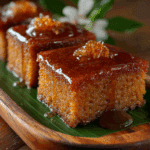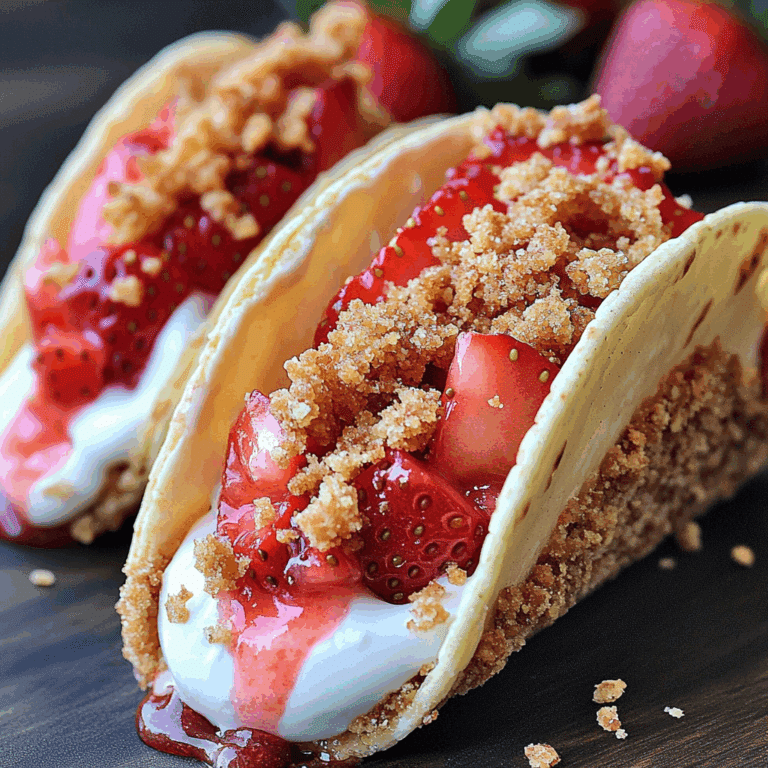Biko (Filipino Sticky Rice Cake)

Biko (Filipino Sticky Rice Cake) is a beloved traditional Filipino dessert known for its rich, sweet flavor and delightfully chewy texture. Made from glutinous rice cooked in coconut milk and sweetened with brown sugar, this sticky rice cake offers a warm, comforting bite that’s perfect for celebrations or a simple treat any day. Whether you’re new to Filipino cuisine or a seasoned foodie, Biko (Filipino Sticky Rice Cake) is a must-try treat that will instantly transport your taste buds to the heart of the Philippines.
Why You’ll Love This Recipe
- Rich flavor: The combination of coconut milk and brown sugar creates a deep, caramel-like sweetness that feels indulgent yet balanced.
- Creamy texture: Glutinous rice cooked slowly ensures a soft, sticky base that’s satisfyingly chewy without being mushy.
- Simple ingredients: Only a handful of pantry staples come together effortlessly to create this comforting dessert.
- Versatile for occasions: Whether for fiestas, holidays, or daily snacks, this recipe suits any gathering or mood.
- Customizable topping: The luscious coconut caramel topping can be enhanced with toasted coconut or latik for added texture.
Ingredients You’ll Need
The magic of Biko (Filipino Sticky Rice Cake) comes from a short list of humble ingredients, each with a crucial role in bringing out its delicious aroma, texture, and sweetness. Using quality coconut milk and fresh glutinous rice will elevate this treat to the next level.
- Glutinous rice: Also known as sticky rice, it provides the chewy and dense foundation for Biko.
- Coconut milk: Adds creaminess and a subtle tropical flavor that balances the sweet elements perfectly.
- Brown sugar: Gives the cake its signature caramelized sweetness with a hint of molasses depth.
- Salt: Just a pinch to enhance the flavors and balance the sweetness.
- Latik (coconut curds): Optional topping that adds crunch and a nutty finish, made by reducing coconut milk.
Variations for Biko (Filipino Sticky Rice Cake)
Biko (Filipino Sticky Rice Cake) is wonderfully adaptable, welcoming tweaks for different textures, flavors, and dietary preferences. Here are some delicious ways to make it your own.
- Ube Biko: Add purple yam (ube) puree into the rice mixture for a vibrant color and subtle earthy sweetness.
- Chocolate Biko: Swirl in cocoa powder or melted dark chocolate for a rich chocolate twist.
- Vegan version: Use coconut sugar instead of brown sugar and ensure coconut milk is unsweetened to keep it fully plant-based.
- Latik topping: Make your own latik for an authentic crunchy topping or sprinkle toasted shredded coconut instead.
- Mix-ins: Stir in chopped nuts or dried fruits for added texture and bursts of flavor.

How to Make Biko (Filipino Sticky Rice Cake)
Step 1: Preparing the Rice
Start by thoroughly rinsing the glutinous rice until the water runs clear to remove excess starch, then soak it in water for about 30 minutes to an hour. This soaking helps achieve a soft, pliable texture once cooked.
Step 2: Cooking the Rice with Coconut Milk
Drain the soaked rice and place it in a pot with fresh coconut milk, a pinch of salt, and half the brown sugar. Cook over medium heat, stirring continuously to prevent burning, until most of the liquid is absorbed and the rice becomes tender and sticky.
Step 3: Making the Caramel Topping
In a separate pan, dissolve the remaining brown sugar in a bit of coconut milk and simmer until it thickens into a luscious caramel sauce. This topping will add depth and a glossy finish to your Biko.
Step 4: Assembling the Biko
Transfer the cooked rice mixture into a greased baking dish or tray, press it evenly to compact the texture, and pour the caramel sauce over the top. Let it soak in for a few minutes before optionally sprinkling latik or toasted coconut for garnish.
Step 5: Cooling and Serving
Allow the Biko (Filipino Sticky Rice Cake) to cool completely, which helps it set and makes slicing easier. Once cooled, cut into squares or diamond shapes and serve.
Pro Tips for Making Biko (Filipino Sticky Rice Cake)
- Rinse the rice well: Washing the rice removes excess starch, preventing the cake from becoming overly gummy.
- Use fresh coconut milk: For the creamiest texture and authentic flavor, fresh or canned coconut milk works best.
- Constant stirring: Prevent the rice from sticking or burning during cooking by stirring steadily.
- Balance sweetness carefully: Adjust brown sugar to your taste to avoid overpowering the natural richness of coconut.
- Latik topping tip: For homemade latik, simmer coconut milk and scoop out the golden curds once they separate for a crunchy finish.
How to Serve Biko (Filipino Sticky Rice Cake)
Garnishes
Sprinkle latik, toasted shredded coconut, or even crushed nuts on top for an added layer of texture and aromatic flavor that complements the sweetness beautifully.
Side Dishes
Biko pairs wonderfully with simple side dishes like fresh tropical fruits, or savory Filipino fare such as grilled meats or pancit for a balanced meal experience.
Creative Ways to Present
Serve Biko in bite-sized portions wrapped in banana leaves for a rustic, traditional feel, or layer it in a glass jar with coconut cream and toasted coconut for an elegant dessert option.
Make Ahead and Storage
Storing Leftovers
Keep leftover Biko (Filipino Sticky Rice Cake) tightly covered in the refrigerator for up to 4 days to preserve freshness and prevent it from drying out.
Freezing
Wrap individual portions in plastic wrap and foil to freeze for up to a month; thaw overnight in the fridge before reheating for best results.
Reheating
Reheat Biko gently in the microwave or on the stovetop with a splash of coconut milk or water to restore moisture and soften the texture before serving.
FAQs
What is Biko made of?
Biko is primarily made from glutinous sticky rice, coconut milk, and brown sugar, cooked together to create a sweet, dense rice cake.
Can I use regular rice instead of glutinous rice?
Regular rice does not have the sticky quality needed for Biko, so glutinous rice is essential for the right texture.
Is Biko vegan-friendly?
Yes, traditional Biko is vegan as it uses coconut milk and no animal products, but always check ingredient labels to be sure.
How long does Biko last?
When refrigerated, Biko stays good for about 4 days; freezing extends its life up to a month.
Can Biko be reheated?
Absolutely! Reheat Biko gently with a bit of moisture to bring back its soft, chewy texture and warm sweetness.
Final Thoughts
If you haven’t yet experienced Biko (Filipino Sticky Rice Cake), this is your invitation to dive into one of the Philippines’ most treasured desserts. Its rich, comforting flavors and tender, chewy texture make it an unforgettable treat perfect for sharing with loved ones or treating yourself after a long day. Give this recipe a try and discover why it holds a special place in so many hearts and celebrations worldwide.
Related Posts
PrintBiko (Filipino Sticky Rice Cake)
Biko (Filipino Sticky Rice Cake) is a traditional Filipino dessert made from glutinous rice cooked in creamy coconut milk and sweetened with rich brown sugar. It features a chewy, dense texture and a luscious caramel coconut topping, making it a perfect treat for celebrations or everyday indulgence. This recipe is simple yet versatile, suitable for all skill levels and customizable with various toppings like latik or toasted coconut.
- Prep Time: 1 hour (including soaking time)
- Cook Time: 45 minutes
- Total Time: 1 hour 45 minutes
- Yield: 8 to 10 servings 1x
- Category: Dessert
- Method: Cooking on stovetop and assembling (no baking required)
- Cuisine: Filipino
- Diet: Gluten Free, Vegan (if using vegan sugar)
Ingredients
Main Ingredients
- 2 cups glutinous rice (sticky rice)
- 2 cups coconut milk (fresh or canned)
- 1 1/2 cups brown sugar, divided
- Pinch of salt
Optional Toppings
- Latik (coconut curds) or toasted shredded coconut
Instructions
- Preparing the Rice: Thoroughly rinse the glutinous rice until the water runs clear to remove excess starch, then soak the rice in water for 30 minutes to 1 hour. Soaking ensures the rice becomes soft and pliable once cooked.
- Cooking the Rice with Coconut Milk: Drain the soaked rice and place it in a pot. Add 2 cups fresh coconut milk, a pinch of salt, and half of the brown sugar (about 3/4 cup). Cook over medium heat, stirring constantly to prevent burning, until most of the liquid is absorbed and the rice is tender and sticky.
- Making the Caramel Topping: In a separate pan, combine the remaining brown sugar (3/4 cup) with a bit of coconut milk. Simmer over low heat, stirring occasionally, until the mixture thickens into a luscious caramel sauce with a glossy finish.
- Assembling the Biko: Transfer the cooked rice mixture into a greased baking dish or tray. Press it evenly and firmly to compact the texture. Pour the caramel sauce evenly over the top. Let it soak for a few minutes, then optionally sprinkle with latik or toasted coconut for added texture and flavor.
- Cooling and Serving: Allow the Biko to cool completely to help it set, making slicing easier. Once cooled, cut into squares or diamond shapes and serve.
Notes
- Rinse the rice well to prevent the cake from becoming overly gummy.
- Use fresh or canned coconut milk for the creamiest texture and authentic flavor.
- Stir constantly during cooking to avoid sticking or burning.
- Adjust the amount of brown sugar to balance the sweetness according to your preference.
- To make homemade latik, simmer coconut milk until it separates and golden curds form; scoop these out for a crunchy topping.
Nutrition
- Serving Size: 1 piece (approx. 100g)
- Calories: 250
- Sugar: 18g
- Sodium: 60mg
- Fat: 8g
- Saturated Fat: 7g
- Unsaturated Fat: 1g
- Trans Fat: 0g
- Carbohydrates: 40g
- Fiber: 1g
- Protein: 3g
- Cholesterol: 0mg
Keywords: Biko, Filipino Sticky Rice Cake, Filipino Dessert, Glutinous Rice Cake, Coconut Milk Dessert, Brown Sugar Cake, Latik Topping







